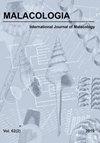Spatiotemporal Variation in Elimia comalensis (Gastropoda: Pleuroceridae) Density and Interspecific Associations with Exotic Thiarid Snails in the Upper San Marcos River, Texas
IF 1
4区 生物学
Q4 ZOOLOGY
引用次数: 0
Abstract
ABSTRACT Freshwater gastropods in the family Pleuroceridae are important components of North American freshwater ecosystems that can greatly influence ecological processes and biotic communities. Elimia is the most taxa rich among pleurocerid genera. Elimia comalensis Pilsbry, 1890, is the only pleurocerid species that occurs in Texas and is currently known to occupy artesian springs and spring-fed river systems associated with the Edwards Plateau region. Published literature on E. comalensis is limited, and little information is currently present regarding explicit patterns of distribution and abundance within most systems currently occupied. We examined temporal and spatial variation of E. comalensis densities in the upper San Marcos River from 2013 to 2016, as well as interspecific affinities between E. comalensis and two invasive thiarid snails. We observed significant annual differences in E. comalensis densities, with greater mean density occurring under low flow conditions in 2014. We also observed significant differences in densities among sites, with greater density occurring at sites with larger and more complex substratum particles. Elimia comalensis exhibited a strong positive relationship with the thiarid snail Tarebia granifera, although data suggest that interspecific competition is limited as these species co-occur at high densities. As anthropogenic impacts continue to impact Edwards Plateau spring systems, further research on the distribution and population dynamics of ecologically important pleurocerid snails, such as E. comalensis, is needed to aid in the conservation of these unique ecosystems.德克萨斯州圣马科斯河上游地区comalelimia(腹足目:胸骨尾螺科)密度的时空变化及其与外来Thiarid蜗牛的种间关联
摘要淡水腹足动物是北美淡水生态系统的重要组成部分,对生态过程和生物群落具有重要影响。狭门属是胸膜科属中最丰富的分类群。limia comalensis Pilsbry, 1890,是德克萨斯州唯一的胸膜虫物种,目前已知占据与爱德华兹高原地区相关的自流泉和泉水河流系统。已发表的关于E. comalensis的文献是有限的,目前关于目前大多数系统中明确的分布模式和丰度的信息很少。研究了2013 - 2016年圣马科斯河上游comalensis密度的时空变化,以及comalensis与两种入侵钉螺的种间亲缘关系。我们观察到comalensis密度的年度差异显著,2014年低流量条件下的平均密度较大。我们还观察到不同地点之间密度的显著差异,更大的密度发生在更大和更复杂的基质颗粒的地点。comalensis与第三干旱蜗牛Tarebia granifera表现出强烈的正相关关系,尽管数据表明,由于这些物种高密度共存,种间竞争有限。随着人类活动对爱德华兹高原春季系统的持续影响,需要进一步研究具有重要生态意义的胸膜纲蜗牛(如E. comalensis)的分布和种群动态,以帮助保护这些独特的生态系统。
本文章由计算机程序翻译,如有差异,请以英文原文为准。
求助全文
约1分钟内获得全文
求助全文
来源期刊

Malacologia
生物-动物学
CiteScore
2.00
自引率
0.00%
发文量
15
审稿时长
3 months
期刊介绍:
Malacologia publishes papers on all groups of the Mollusca. Malacologia specializes in publishing long papers and monographic treatments. Complete data are especially appreciated. Papers must be of interest to an international readership. Papers in systematics, ecology, population ecology, genetics, molecular genetics, evolution and phylogenetic treatments are especially welcomed. Also welcomed are letters to the editor involving papers published or issues of import to science of the day.
 求助内容:
求助内容: 应助结果提醒方式:
应助结果提醒方式:


